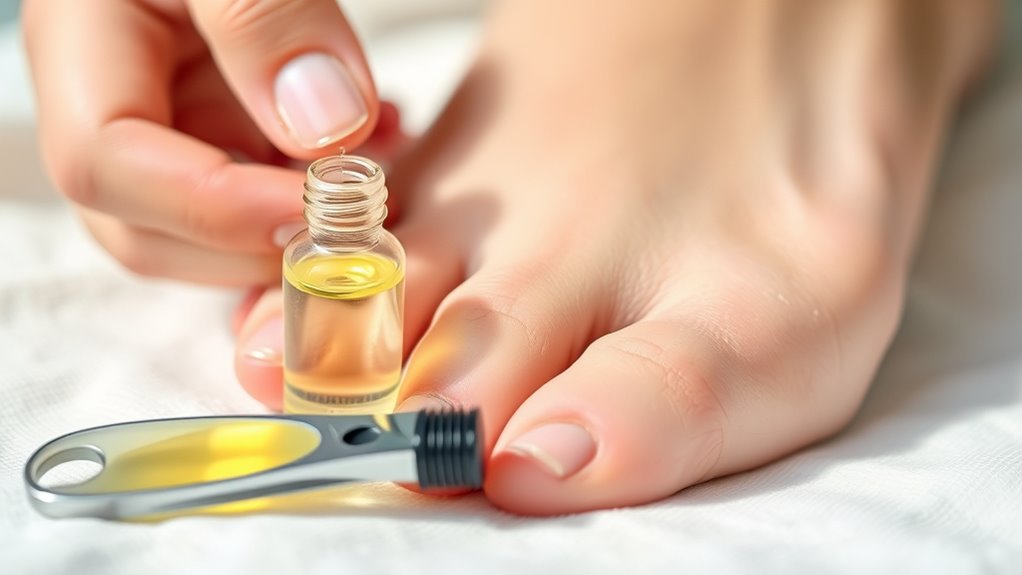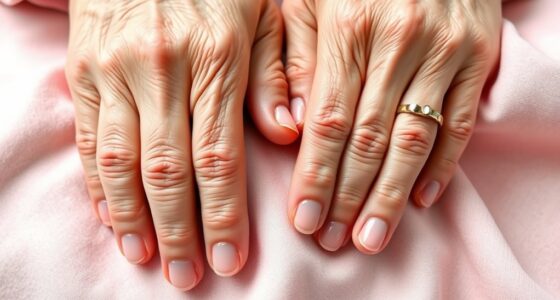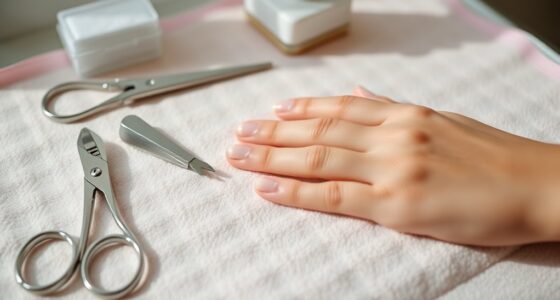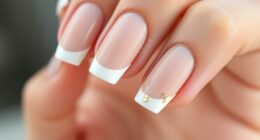To care for your nails with diabetes, regularly inspect them for cuts, discoloration, or infections, and keep them dry and clean. Trim nails straight across with sanitized tools, avoiding harsh products or artificial nails. Moisture and poor hygiene can lead to infections, so dry your hands and feet thoroughly after washing. Choose gentle, non-toxic nail care products, and seek professional help if you notice persistent issues. Continuing this advice can help you better understand maintaining healthy nails.
Key Takeaways
- Inspect nails daily for cuts, discoloration, or infections, and keep them clean and dry to prevent complications.
- Use sharp, sanitized tools to trim nails straight across and avoid ingrown nails or injuries.
- Choose hypoallergenic, non-toxic nail products and avoid harsh chemicals or artificial nails.
- Dry nails thoroughly after washing or bathing to prevent fungal and bacterial growth.
- Address signs of infection promptly with appropriate treatment and avoid sharing nail tools.
Understanding the Risks for Nails in Diabetes
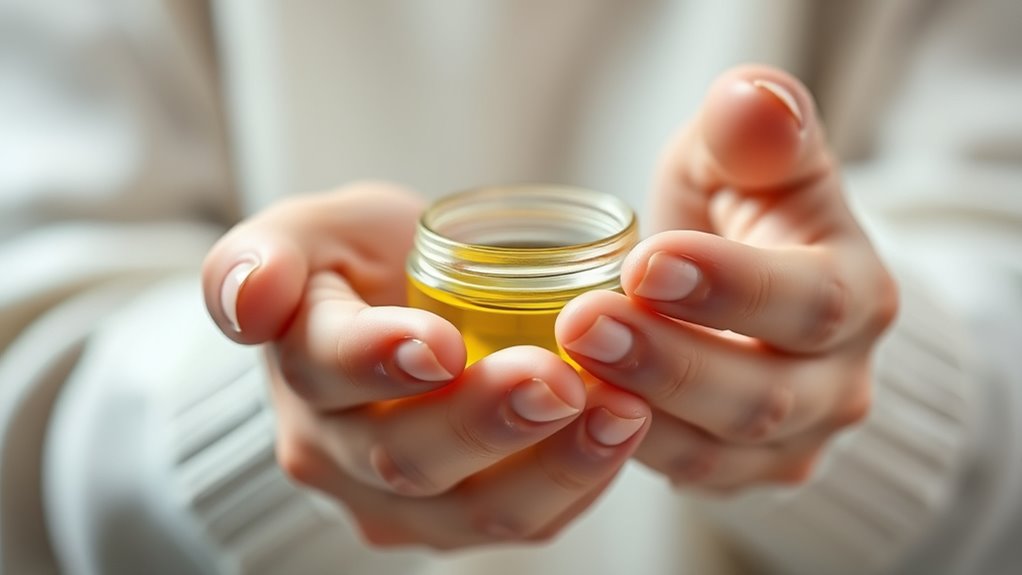
If you have diabetes, you’re more prone to nail problems because high blood sugar levels can impair blood flow and cause nerve damage. Reduced blood flow makes it harder for nutrients and oxygen to reach your nails, slowing growth and healing. Nerve damage can diminish sensation in your fingertips, making it easier to miss injuries or infections. Without proper blood circulation, your body’s ability to fight off fungal or bacterial infections weakens, increasing the risk of nail issues. Over time, these factors can lead to brittle, discolored, or deformed nails. Recognizing these risks helps you stay alert for early signs of nail problems. Managing blood sugar levels effectively is essential to maintaining healthy nails and preventing complications associated with poor circulation and nerve damage. Additionally, using smart hygiene devices can help ensure proper nail care and reduce infection risks, especially when combined with regular monitoring of nail health. Incorporating proper hygiene practices and essential oils safe for skin can further support nail health and prevent infections. Being aware of blood circulation issues can help you take proactive steps to protect your nails and overall health.
Daily Nail Inspection and Monitoring

Since nerve damage can reduce your sensitivity to pain and temperature changes, it’s important to inspect your nails daily. Check for any cuts, blisters, discoloration, or signs of infection. Look closely at your cuticles and the nail bed for abnormalities. When considering nail polish, ensure it’s safe for diabetics—prefer formaldehyde-free options and avoid nail polish with harsh chemicals. If you like nail art, take extra precautions: avoid over-the-top designs that require frequent removal or harsh removal methods, which can damage the nails. Be cautious with nail polish removers containing acetone. Regular monitoring helps catch issues early, preventing infections or complications. Developing this habit keeps your nails healthy and reduces the risk of unnoticed problems escalating. Additionally, understanding indoor air quality can help you maintain a healthier environment, which is beneficial for overall well-being. Improving air quality can reduce exposure to airborne irritants that may affect your skin and nails. Creating a healthy indoor environment can significantly contribute to your overall health and aid in maintaining good nail health. Being aware of affiliate product options for nail care can also support safer maintenance routines.
Proper Nail Trimming Techniques

When trimming your nails, always use clean, sharp tools designed for the task. Cut straight across to prevent ingrown nails and reduce injury risk. Proper technique helps keep your nails healthy and avoids complications.
Use Proper Tools
Using the right tools is essential for safe and effective nail trimming, especially if you have diabetes. Choose sharp, clean nail scissors or clippers designed for toenails, and avoid dull or blunt tools that can cause injury. Using proper tools helps prevent tearing or ingrown nails, reducing infection risk. While you may enjoy nail art or applying nail polish, always remove polish thoroughly before trimming to see your nails clearly. Never use scissors or tools not meant for nails, as they can cause damage. Keep your tools sanitized to minimize bacteria. If you’re unsure about your technique or tools, consult a professional. Proper tools and careful handling keep your nails healthy and safe, supporting your overall foot care routine. Additionally, understanding proper foot care principles can further help prevent complications associated with diabetes. Being aware of diabetic foot risks can guide you in maintaining healthier nails and preventing infections.
Trim Straight Across
To prevent ingrown nails and infections, it’s important to trim your nails straight across. Use clean, sharp nail scissors or clippers, and avoid shaping the edges into curves. Cutting straight reduces the risk of nails growing into the skin, which is especially important if you wear nail polish or acrylic nails, as these can hide issues. Visualize your nails like this:
| Natural Nail Shape | Trimmed Straight Across |
|---|---|
| Slight curve at edges | Flat, even across the top |
| Ends tapering inward | No rounded corners or corners cut |
Imagine your nails as a flat surface, free of sharp angles. Proper trimming helps maintain healthy nails and prevents complications related to diabetes. Maintaining nail health is especially important for individuals with diabetes to prevent infections and other complications. Additionally, understanding proper sound design techniques can be beneficial for creating educational content or tutorials on nail care, making information more engaging and accessible. Being aware of nail anatomy can further improve your trimming technique and overall nail health. Taking the time to learn about nail growth patterns can also assist in achieving more precise and safe trims.
Keeping Nails Clean and Dry
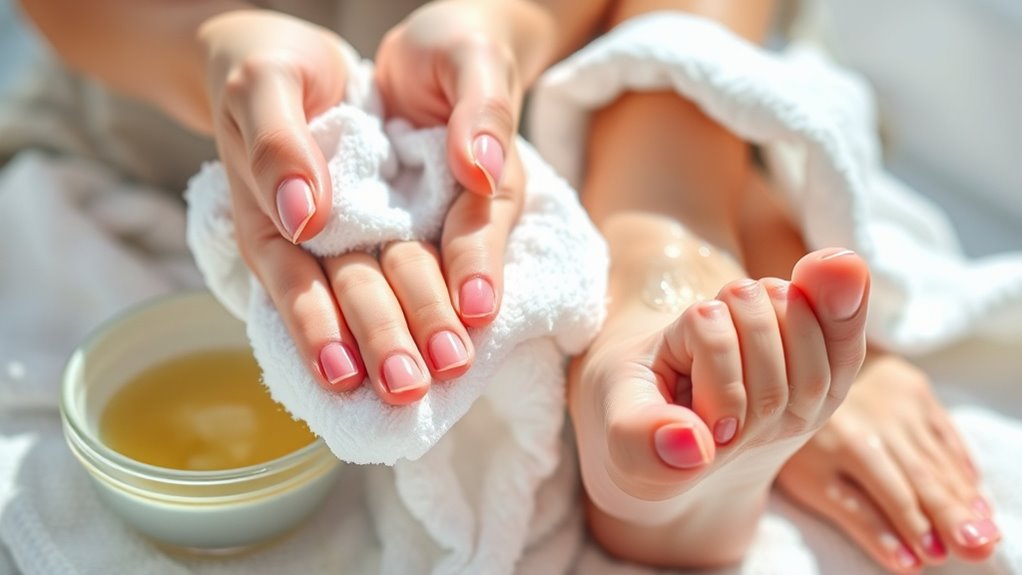
Keeping your nails clean and dry helps prevent infections. Make sure to wash your hands regularly and dry your nails thoroughly afterward. Avoid moisture traps, like prolonged exposure to water or damp environments, to keep your nails healthy. To further protect your nails, consider using appropriate nail care techniques that are gentle and suitable for diabetic individuals. Additionally, maintaining awareness of Louisiana Alimony Laws can help in understanding financial responsibilities post-divorce, which may impact your overall health and well-being. Incorporating proper hygiene practices into your daily nail care routine can also lead to better outcomes.
Regular Hand Washing
Since bacteria and fungi thrive in damp environments, washing your hands regularly is essential for maintaining healthy nails, especially if you have diabetes. Good hand hygiene helps remove dirt, bacteria, and fungi that can cause infections. Make it a habit to wash your hands thoroughly with soap and water for at least 20 seconds, paying attention to the areas around your nails. Dry your hands completely afterward, as moisture can promote bacterial growth. Additionally, practicing regular hand washing can help prevent trust issues that may arise from unnoticed infections or complications. Regular hand washing also supports AI-driven solutions in healthcare by reducing infection risks and improving patient outcomes. Being aware of common nail infections can further help you recognize early signs and seek prompt treatment. By practicing regular hand washing, you reduce the risk of nail infections and other complications associated with diabetes. Proper hand hygiene is a simple yet effective step in infection prevention and maintaining overall nail health. Keep this routine consistent to protect your nails and skin from potential harm.
Proper Nail Drying
After washing your hands and nails thoroughly, it’s just as important to dry them completely. Moisture trapped under your nail polish or around your acrylic nails can lead to infections or fungal growth. Use a clean towel or a soft cloth to gently pat your nails dry, ensuring no dampness remains. If you wear nail polish, make sure it’s fully dry before exposing your nails to water again. For those with acrylic nails, pay extra attention to the edges where water can seep in. Proper drying helps prevent bacterial buildup and reduces the risk of complications, especially for people with diabetes. Keeping your nails dry and clean is a simple but essential step in maintaining healthy nails and avoiding issues down the line.
Avoid Moisture Traps
To prevent infections, it’s essential to avoid moisture traps around your nails. Moisture buildup creates a perfect environment for fungi and bacteria to thrive, increasing your risk of infections. Make sure your nails stay dry after washing or bathing by thoroughly drying your hands and feet, especially around the nail beds. Avoid wearing damp socks or shoes that trap moisture, and choose breathable footwear whenever possible. Keep nail tools clean and dry, and never leave nails wet or dirty for extended periods. By maintaining dryness, you help prevent fungal infections and promote healthy nail growth. Regularly checking your nails for signs of moisture or discoloration can also catch issues early. Staying vigilant about moisture control is a key step in fungal prevention for people with diabetes.
Choosing the Right Nail Care Products

How can you guarantee your nail care products support healthy, safe nails when you have diabetes? Start by choosing gentle, hypoallergenic products free of harsh chemicals. Look for nail polish labeled as “diabetes-safe,” which typically avoids toxic ingredients that can damage your nails or cause infections. Avoid artificial nails unless your healthcare provider approves, as they can trap moisture and bacteria, increasing infection risk. When selecting nail polish or treatments, opt for non-toxic, breathable formulas that allow your nails to stay healthy. Always check labels carefully, and skip products with formaldehyde, toluene, or phthalates. Using the right products helps protect your nails from damage and infection, promoting healthier nails and reducing complications related to diabetes.
Managing Nail Infections Effectively

Nail infections can pose serious health risks for people with diabetes, so managing them promptly and effectively is essential. If you notice signs of nail fungus or other infections, start treatment immediately to prevent worsening. Keep your nails clean and dry, as moisture promotes infection and nail fungus growth. Use antifungal creams or medications prescribed by your healthcare provider, and avoid sharing nail tools to prevent infection prevention. Regularly inspect your nails for discoloration, thickening, or brittleness. If an infection develops, don’t delay seeking professional advice. Proper nail hygiene, combined with timely treatment, helps control infections and reduces complications. Remember, addressing nail issues early is key to maintaining overall foot health and preventing serious complications linked to diabetes.
When to Seek Professional Nail Care
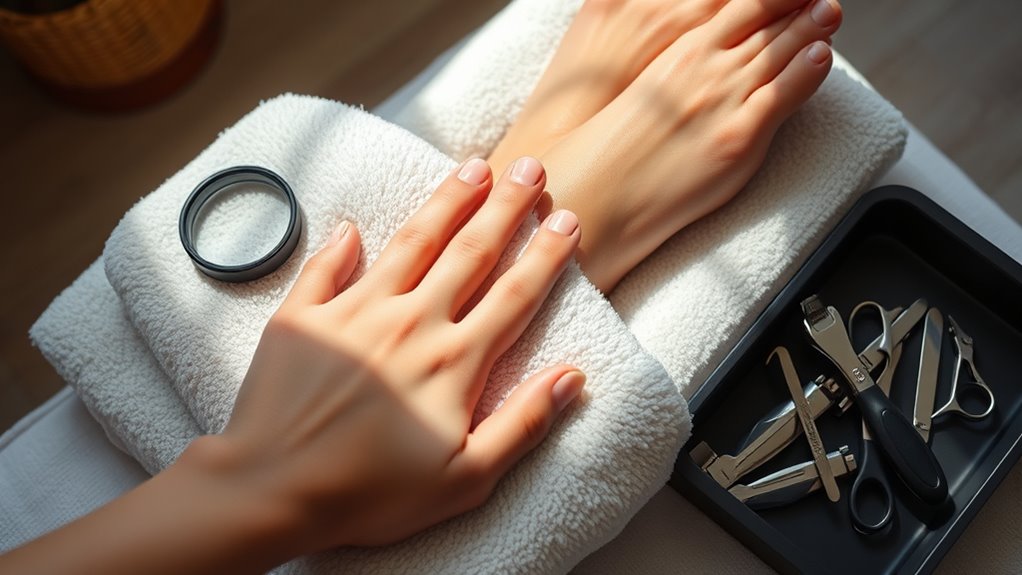
Recognizing when professional nail care is needed can prevent minor issues from turning into serious health problems. If you notice persistent pain, redness, swelling, or bleeding around your nails, it’s time to see a professional. Poor nail salon safety practices, such as unsterilized tools, can increase the risk of infections, so choose reputable salons. If you experience an injury or nail damage that won’t heal or causes severe discomfort, seek emergency nail care immediately. Regular check-ups with a podiatrist or trained nail technician can help catch issues early. Avoid attempting to handle complicated nail problems yourself, especially if you have diabetes, as complications can escalate quickly. Knowing when to consult a professional guarantees your nails stay healthy and reduces the risk of complications.
Tips for Promoting Healthy Nail Growth
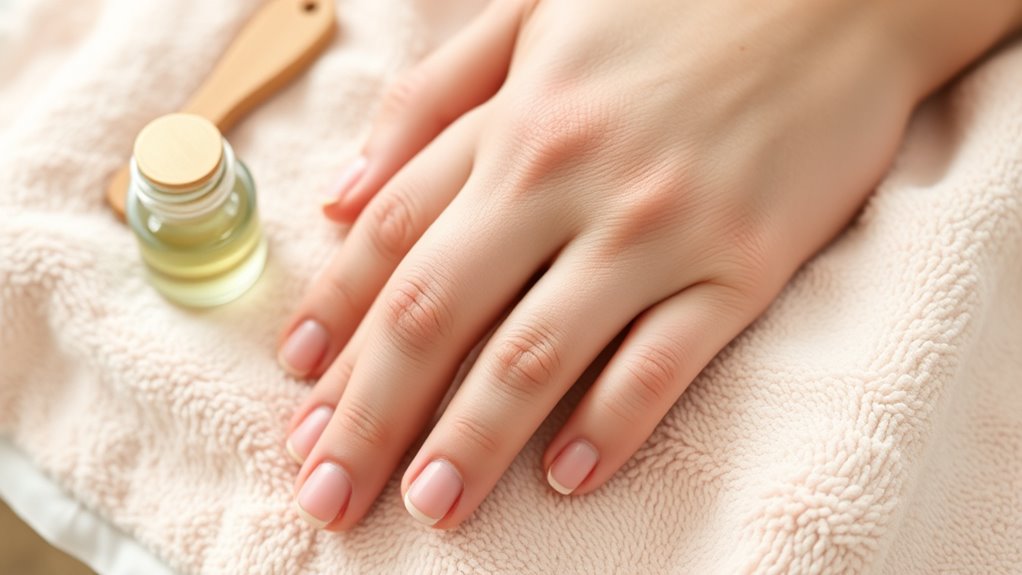
Maintaining healthy nail growth requires consistent care and attention to your overall health. Keep your nails clean and moisturized to prevent dryness and cracking. Avoid using nail polish or artificial nails excessively, as they can weaken your nails or cause infections. If you choose to wear nail polish, opt for breathable formulas and remove them regularly to let your nails breathe. Be gentle when filing or trimming your nails, avoiding aggressive buffing or cutting too close to the skin. Protect your nails from trauma by wearing gloves during household chores or gardening. Eating a balanced diet rich in vitamins and minerals supports nail strength and growth. Regularly check your nails for signs of infection or abnormal changes, and consult a professional if needed.
Frequently Asked Questions
Can Diabetes Cause Permanent Nail Damage?
Diabetes can cause some nail issues, but permanent nail damage isn’t common if you maintain good nail health awareness. Diabetic nail damage might include fungal infections or thickened nails, which are treatable. However, unchecked infections can lead to more serious problems. Keep your nails clean, moisturized, and see a healthcare provider if you notice changes. Staying vigilant helps prevent lasting damage and maintains your overall nail health awareness.
Are There Specific Nail Polishes Recommended for Diabetics?
When choosing nail polishes, you want options that are safe and gentle. Look for diabetic friendly nail polish and hypoallergenic nail products that reduce the risk of irritation or allergic reactions. These polishes often avoid harsh chemicals like formaldehyde and toluene. By selecting these, you protect your nails and overall health, ensuring your nail care routine stays safe, effective, and worry-free. Always check labels and consult your healthcare provider for personalized advice.
How Often Should I Visit a Podiatrist for Nail Care?
You should visit a podiatrist for regular checkups, typically every 3 to 6 months, especially if you have diabetes. These visits help with preventative care, catching issues like infections or nail problems early. If you notice any changes in your nails or experience discomfort, don’t wait—schedule an appointment sooner. Consistent visits guarantee your nails stay healthy and reduce the risk of complications related to diabetes.
Can Diet Impact the Health of My Nails?
Your diet can definitely impact your nail health. Nutritional deficiencies, like lacking vitamins and minerals, can lead to brittle or weak nails. Eating a balanced diet rich in biotin, zinc, and iron helps strengthen nails. If you’re not getting enough through food, consider dietary supplements, but always talk to your doctor first. Proper nutrition supports overall nail health and can prevent issues related to poor diet choices.
What Are Signs of Serious Nail Complications in Diabetes?
If you notice nail fungus or nail discoloration that seems to be taking over like a bad movie, it’s serious. These signs could mean infections or even more dangerous complications from diabetes. Watch for thick, brittle nails or changes in color that don’t go away. Don’t ignore these symptoms—they could be signs of a bigger problem. See your healthcare provider promptly to prevent complications and keep your nails healthy.
Conclusion
By following these nail care tips, you can keep your nails healthy and avoid complications. Remember, neglecting your nails today is like ignoring a leaky ship in the age of sail—things can quickly go awry. Stay vigilant with daily inspections, proper trimming, and professional checkups. With consistent care, you’ll navigate your diabetes journey smoothly, keeping your nails strong and infection-free—because good nail health isn’t just a modern luxury, it’s a crucial part of your well-being.
